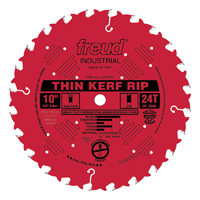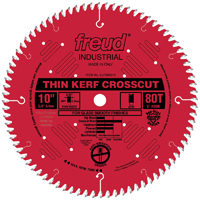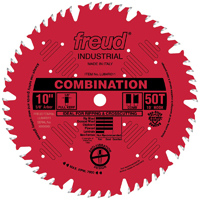Choosing the right saw blade for a cutting task can mean the difference between misery and glory. If you’ve ever tried to rip a piece of 4/4 oak with a saw blade that’s not designed for ripping, or tried making a cross-cut on a piece of plywood with a rip blade you know what I’m talking about. There are many different saw blades on the market and lots of accompanying saw blade lingo to digest. It’s easy to get bogged down reading about positive versus negative hook angles, thin versus full kerf, expansion slots, gullet depth, tooth grind patterns, etc. It can be downright overwhelming to a novice. But, as I see it, the first order of business is to define what the blade will be used for. That is, will it be used for ripping, cross-cutting, or both? If you can answer this simple question, you’re well on your way to selecting the right blade.
Types of Saw Blades
All saw blades boil down to these basic types: rip blades, crosscut blades, and combination blades. [Purists might say that one should only consider rip or crosscut blades but that’s their problem]. Each blade type, and reasons for choosing one type over another are described below.
Rip Blades
Rip blades are designed for ripping boards into narrower boards. They cut aggressively, removing large amounts of material, and often don’t leave a mirror smooth finish. Compared to other blades, rip blades have a relatively small number of teeth, usually 20 to 24 but sometimes 30, and deep gullets (the notch in front of the tooth). The hook angle of the teeth may be as much as 20 degrees, which means the teeth are slanted forward more aggressively than the teeth on a crosscut blade.
A rip blade is used exclusively on table saws. (ok, some people use radial arm saws for ripping but that’s not too common). If you’re looking for a blade for your miter saw, take rip blades off the list. If you have a table saw, you’ll want at least one rip blade, probably two, maybe even three. For the majority of lumber ripping tasks in my shop, I use a thin kerf rip blade with 24 teeth. For ripping plywood and other sheet stock, I use a combination blade with 50 teeth if a glue quality edge is required or the afore-mentioned 24 tooth blade if a slightly rough edge will suffice.
Crosscut Blades
Crosscut blades are designed for cutting boards or panels across the grain of the wood. Compared to rip blades, crosscut blades have more teeth, usually 60 to 80, and the teeth have a less aggressive hook angle. This allows for a reduced feed rate and more individual cuts per second, resulting in a smoother cut line. The teeth are angled or beveled to form a knife-like edge on either side of the blade which also contributes to a quality cut with less tearing. The technical term for this tooth grind pattern is an alternate top bevel (ATB). Rip blades generally have a flat top grind which allows for more efficient removal of material but a rougher cut surface.
If you have a miter saw or radial arm saw, or make cross cuts on your tablesaw, you’ll need a crosscut blade. Probably several blades. Just make sure the hook angle of the blade is appropriate for the tool. Sliding miter saws and radial arm saws tend to overfeed or grab the wood which can result in tearing and perhaps even danger to yourself. For these tools, use a crosscut blade with a less aggressive hook angle, say -5 to 5 degrees. For a tablesaw or a non-sliding miter saw, a hook angle around 10 degrees is acceptable.
Combination Blades
Combination blades are designed for both ripping and cross-cutting. They are useful if you frequently perform a mix of rip cuts and cross cuts and many woodworkers keep a combo blade on their tablesaw for this reason. The tradeoff is that a combination blade won’t rip quite as effectively as a rip blade or cross cut quite so smoothly as a dedicated cross cut blade – generally speaking – but it will save you lots of time swapping out blades. If I were going to rip a hundred board feet of maple, I would opt to use a rip blade but if I was going to rip just a few boards, cross cut them to length, rip a few more boards, and so on, a combination blade would be a good choice.
A quality combination blade leaves a nicely burnished surface – when all goes well. But, if the blade get a little dull, or pitch has built up on it, or even if the gullets on the blade do not clear the work piece, burning of the wood can occur. Just keep this in mind and try to be vigilant about maintaining your saw blade and using it properly. Burning is most likely to be an issue when ripping the really hard hardwoods such as cherry, maple, and oak.
Thin Versus Full Kerf
Should you buy a thin kerf or a full kerf blade? This is a common question among woodworkers. The advantage of a thin kerf blade is that it requires less power to use because less material is removed (a typical full kerf blade is about one-fourth thicker than a thin kerf blade). You can cut through material quicker and with less strain on the motor, extending the life of the motor. This is especially important if you have an underpowered saw. A thin kerf blade also wastes less material, conserving more of your hard-earned wood for project use and reducing sawdust collection requirements.
Conventional wisdom has it that the disadvantage of thin kerf blades is that they can deflect and warp from overheating because the plate width is narrower than that of a full kerf blade. However, thin kerf blade technology has come a long ways over the years with features like anti-stick coatings and expansion slots so warping is not the issue it once may have been. Just be careful not to overwork the blade; for example, ripping a 100 board feet of hard maple at one time.
Fine Woodworking did some tests on thin kerf blades in 2009 and found that their quality of cut rivaled that of full kerf blades and that warping was not a problem. I have used thin kerf rip blades for years and have been quite pleased with them. I plan to continue using thin kerf blades in the future and think they are a worthwhile option for any woodworker, especially for ripping tasks.
Saw Blades for Sheet Stock
Specialized blades are available for cutting sheet stock such as plywood and melamine. These blades, often referred to as plywood or laminate blades, have a large number of teeth (80 teeth is common) with an alternating top bevel grind for slicing through the material. The hook angle is conservative, usually no more than 5 degrees, and the gullet is small. This makes for a smooth cut with minimal chip-out. If you plan to make quality furniture from manufactured sheet stock, it’s definitely worth investing in a specialty blade.
Steel or Carbide
For the most part, it makes sense to purchase blades with carbide teeth rather than steel. The teeth will stay sharper much longer and you get better bang for your buck in the long term. However, steel teeth are a viable option for cutting lumber of dubious origin or lumber that you suspect may contain nails, screws, or other debris. A sacrificial blade as it were.
Brand of Blade
Determining the type of blade is a fairly straightforward process. For example, you probably know if you want a rip versus a crosscut or combination blade and whether a sheet stock blade is needed or not. The tricky part for many people is selecting abrand of saw blade because there are many quality brands to choose from and we all have different budgetary constraints.
Two brands that are often discussed in woodworking message boards are Freud and Forrest. I mostly use Freud blades in my woodshop and have had excellent results with them. I have no qualms about recommending this brand based on my personal experience. Forrest blades have a solid reputation for longevity and quality of cut and indeed, most of the reviews that I’ve read have been very positive. I doubt one could go wrong with this brand although the higher price tag on their premium blades may be outside some woodworker’s budgets.
Some other brands that receive favorable mention in the message boards are Amana, CMT, Everast, Oldham, Ridge Carbide, Systimatic, and Tenryu. I have not used these brands personally and so cannot comment on them. They are presented here as brands worthy of further investigation.




